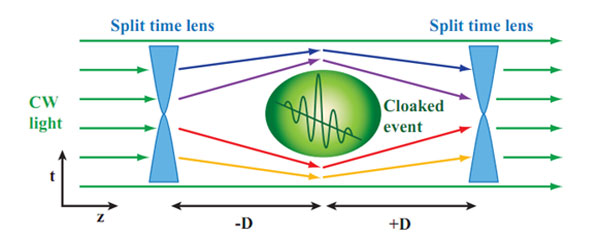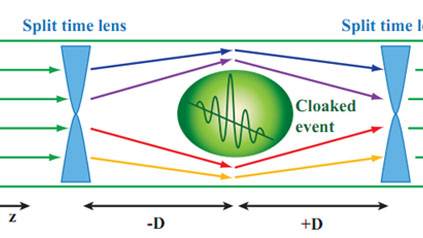Scientists Punch a Hole in the Fabric of Time with a "Time Cloak"
Source: technologyreview.com

Physicists have created a "hole in time" using the temporal equivalent of an invisibility cloak.
Invisibility cloaks are the result of physicists' newfound ability to distort electromagnetic fields in extreme ways. The idea is steer light around a volume of space so that anything inside this region is essentially invisible.
The effect has generated huge interest. The first invisibility cloaks worked only at microwave frequencies but in only a few years, physicists have found ways to create cloaks that work for visible light, for sound and for ocean waves. They've even designed illusion cloaks that can make one object look like another.
Today, Moti Fridman and buddies, at Cornell University in Ithaca, go a step further. These guys have designed and built a cloak that hides events in time.
Time cloaking is possible because of a kind of duality between space and time in electromagnetic theory. In particular, the diffraction of a beam of light in space is mathematically equivalent to the temporal propagation of light through a dispersive medium. In other words, diffraction and dispersion are symmetric in spacetime.
That immediately leads to an interesting idea. Just as its easy to make a lens that focuses light in space using diffraction, so it is possible to use dispersion to make a lens that focuses in time.
Such a time-lens can be made using an electro-optic modulator, for example, and has a variety of familiar properties. "This time-lens can, for example, magnify or compress in time," say Fridman and co.
This magnifying and compressing in time is important.
The trick to building a temporal cloak is to place two time-lenses in series and then send a beam of light through them. The first compresses the light in time while the second decompresses it again.
But this leaves a gap. For short period, there is a kind of hole in time in which any event is unrecorded.
So to an observer, the light coming out of the second time-lens appears undistorted, as if no event has occurred.
In effect, the space between the two lenses is a kind of spatio-temporal cloak that deletes changes that occur in short periods of time.
The device has some limitations. The Cornell time cloak lasts only for 110 nanoseconds--that's not long. And Fridman and co say the best it can achieve will be 120 microseconds.
But it's early days yet. Given the rapid development of spatial cloaks, it'd be a brave man who'd bet on this being the last word.
Fridman and pals have clearly made themselves an interesting toy but they modestly refrain from speculating about the applications for their time cloak.
However, that's a task well suited to readers of the Physics arXiv Blog. If you have any suggestions, leave them here.
Ref: arxiv.org/abs/1107.2062: Demonstration Of Temporal Cloaking






















